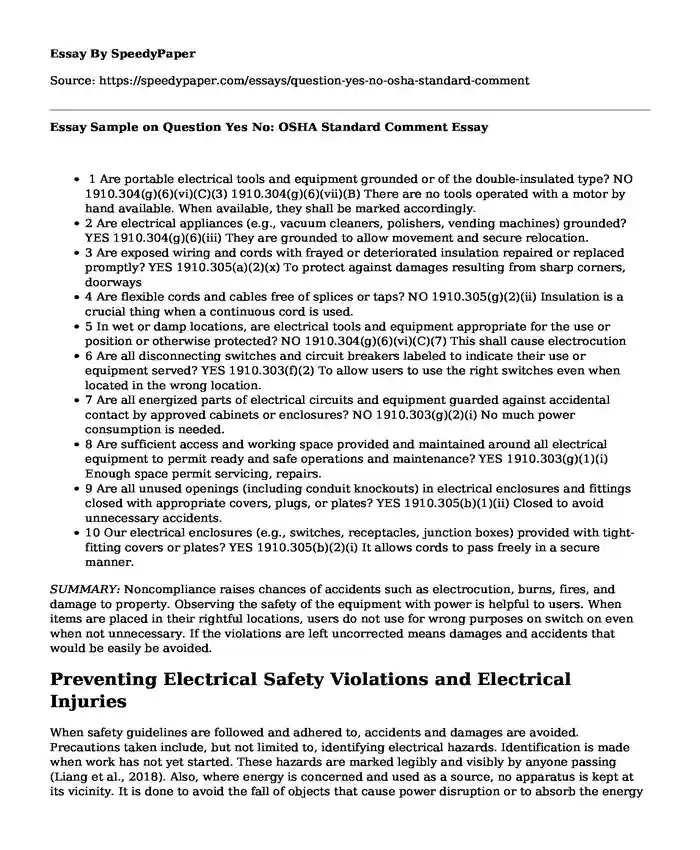
| Type of paper: | Case study |
| Categories: | Company Human resources Security Healthcare |
| Pages: | 3 |
| Wordcount: | 693 words |
- 1 Are portable electrical tools and equipment grounded or of the double-insulated type? NO 1910.304(g)(6)(vi)(C)(3) 1910.304(g)(6)(vii)(B) There are no tools operated with a motor by hand available. When available, they shall be marked accordingly.
- 2 Are electrical appliances (e.g., vacuum cleaners, polishers, vending machines) grounded? YES 1910.304(g)(6)(iii) They are grounded to allow movement and secure relocation.
- 3 Are exposed wiring and cords with frayed or deteriorated insulation repaired or replaced promptly? YES 1910.305(a)(2)(x) To protect against damages resulting from sharp corners, doorways
- 4 Are flexible cords and cables free of splices or taps? NO 1910.305(g)(2)(ii) Insulation is a crucial thing when a continuous cord is used.
- 5 In wet or damp locations, are electrical tools and equipment appropriate for the use or position or otherwise protected? NO 1910.304(g)(6)(vi)(C)(7) This shall cause electrocution
- 6 Are all disconnecting switches and circuit breakers labeled to indicate their use or equipment served? YES 1910.303(f)(2) To allow users to use the right switches even when located in the wrong location.
- 7 Are all energized parts of electrical circuits and equipment guarded against accidental contact by approved cabinets or enclosures? NO 1910.303(g)(2)(i) No much power consumption is needed.
- 8 Are sufficient access and working space provided and maintained around all electrical equipment to permit ready and safe operations and maintenance? YES 1910.303(g)(1)(i) Enough space permit servicing, repairs.
- 9 Are all unused openings (including conduit knockouts) in electrical enclosures and fittings closed with appropriate covers, plugs, or plates? YES 1910.305(b)(1)(ii) Closed to avoid unnecessary accidents.
- 10 Our electrical enclosures (e.g., switches, receptacles, junction boxes) provided with tight-fitting covers or plates? YES 1910.305(b)(2)(i) It allows cords to pass freely in a secure manner.
SUMMARY: Noncompliance raises chances of accidents such as electrocution, burns, fires, and damage to property. Observing the safety of the equipment with power is helpful to users. When items are placed in their rightful locations, users do not use for wrong purposes on switch on even when not unnecessary. If the violations are left uncorrected means damages and accidents that would be easily be avoided.
Preventing Electrical Safety Violations and Electrical Injuries
When safety guidelines are followed and adhered to, accidents and damages are avoided. Precautions taken include, but not limited to, identifying electrical hazards. Identification is made when work has not yet started. These hazards are marked legibly and visibly by anyone passing (Liang et al., 2018). Also, where energy is concerned and used as a source, no apparatus is kept at its vicinity. It is done to avoid the fall of objects that cause power disruption or to absorb the energy that is not required.
The use of non-conductors when handling electrical materials is advocated. Just a slight electric shock is enough to cause devastating damage. For instance, when an individual is using a ladder and accidentally held a live wire. Besides, wiring ought to be done systematically to avoid future electric fire that might be caused by water on outlets (Bridges, 2017).
When wiring, the electricians are advised not to use metallic objects to nail. Damaged cords or open ones may lead to burns, fire, and electric shock; thus, a replacement is necessary. The use of wires that are almost damaged is not guaranteed safety to the user. Also, the use of protective gear and coverings when around electrical appliances are highly recommended.
Furthermore, items around wet areas are insulated to prevent water from getting into contact with the live wire. Appliances are placed in their designated places to prevent people from using them for the wrong purposes or being switched on and off unnecessarily. Electrical items are always labeled clearly to avoid them being damaged or prevent them from causing accidents. For flexible cords and cables, joints are avoided, and when introduced in a line, electrical tapes are used. Space for each item created is enough to allow maintenance, repairs, and servicing (Liang et al., 2018).
References
Bridges, R. (2017, August 1). Industrial safety tips to help avoid electrical injuries. Retrieved from https://www.ishn.com/articles/106953-industrial-safety-tips-to-help-avoid-electrical-injuries
Z. Liang et al., "Classification Method of Typical Electric Shock Scenes in Medium Voltage Distribution Network," 2018 International Conference on Power System Technology (POWERCON), Guangzhou, 2018, pp. 454-460.
Cite this page
Essay Sample on Question Yes No: OSHA Standard Comment. (2023, May 02). Retrieved from https://speedypaper.com/essays/question-yes-no-osha-standard-comment
Request Removal
If you are the original author of this essay and no longer wish to have it published on the SpeedyPaper website, please click below to request its removal:
- Postmodern Geography Scholars Essay Example
- Essay Example in IT Project Management
- L.A. Confidential - Movie Review Essay Example
- Teamwork Reflection. Paper Example
- Free Essay. the Importance of Health Maintenance, Screening, and Management of Hypertension
- Literary Analysis Essay on The Social Life of DNA
- Web Server Patch Management - Free Paper Sample
Popular categories




